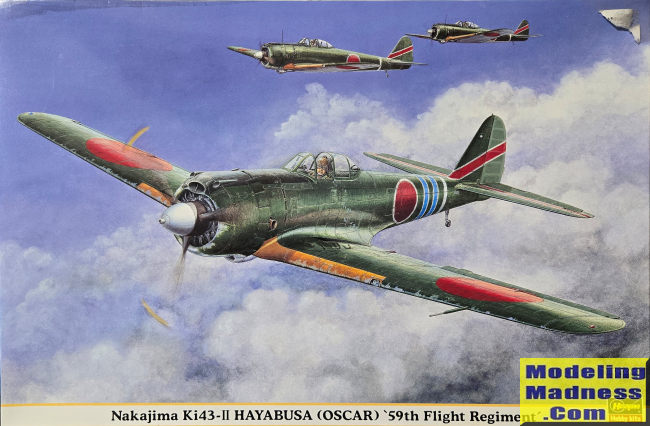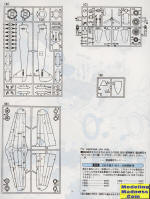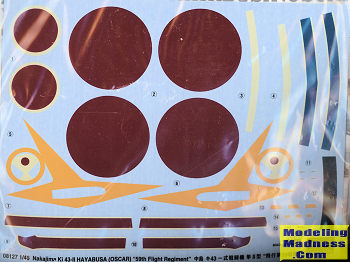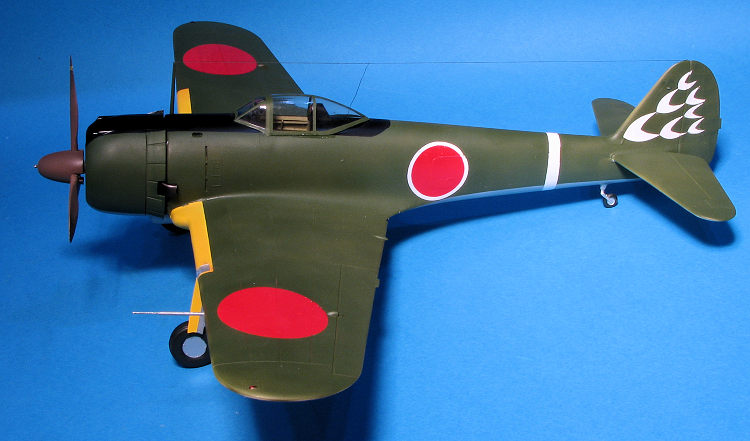
Hasegawa 1/32 Ki-43-II 'Hayabusa': 59th Flight Regiment
| KIT #: | 08127 |
| PRICE: | 3200 yen when new |
| DECALS: | Two options |
| REVIEWER: | Scott Van Aken |
| NOTES: | 2001 release |

| HISTORY |
The Ki-43 was the most widely used Army fighter, and equipped 30 sentai FR,(flight regiment) and 12 chutais IS,(independent squadrons). The first unit equipped with the Ki 43-I was the 59th FR at Hankow Airfield, during JuneľAugust 1941 and began operational sorties over Hengyang on 29 October 1941. The second unit to re-equip with the new Aircraft was the 64th FR, from August to November 1941.
The first version, Ki-43-I, entered service in 1941, the Ki-43-II in December 1942, the Ki-43-II-Kai in June 1943, and the Ki-43-IIIa in summer 1944. The aircraft fought in China, Burma, the Malay Peninsula, New Guinea, the Philippines, South Pacific islands and the Japanese home islands.
Hayabusas were well liked in the JAAF because of the pleasant flight characteristics and excellent maneuverability, and almost all JAAF fighter aces claimed victories with Hayabusa in some part of their career. At the end of the war, most Hayabusa units received Ki-84 Hayate "Frank" fighters, but some units flew the Hayabusa to the end of the war. The top-scoring Hayabusa pilot was Sergeant Satoshi Anabuki with 39 confirmed victories, almost all scored with the Ki-43.
After the war, some captured examples served in limited numbers in the French Air Force in Indochina against Viet Minh rebels.
Ki-43s abandoned in the Netherlands East Indies were taken over by the newly declared Indonesian government and put into service during the fighting against Dutch forces
| THE KIT |
 This
is not a new kit with the initial release being 1969. However, despite the
raised panel lines, the kit itself looks to be very good and the moldings are in
super shape. It has also, to my knowledge, not been superceded by a newer
tooling.
This
is not a new kit with the initial release being 1969. However, despite the
raised panel lines, the kit itself looks to be very good and the moldings are in
super shape. It has also, to my knowledge, not been superceded by a newer
tooling.
Looking through the instructions I noticed that this kit can either be built as a Ki-43-IIa or Ki-43-IIb. The visual difference is that the a model has the collector exhaust coming straight out of the side of the cowling, while the b version has a longer exhaust pointed back as shown on the box art. As you many have read, the b version can carry drop tanks while both can carry bombs. Both items are included in the kit.
The kit comes with a relatively nice engine that has separate cylinders. Both banks are built up and the intake or exhaust piping is added before they are mated as are the pushrod assemblies. The Ki-43-IIa has a circular oil radiator that fits in the very front as on the earlier -I Hayabusa. Now would be a good time to mention that one has to cut the fuselage for the exhaust that you choose so you need to decide early in the build if you will be doing an a or b version.
A well done interior is provided with all the usual accoutrements and controls. The inside of the fuselage halves has some nice detail as well. In line with other large Hasegawa kits of this era, a pilot figure is included. The wings are already slotted for the racks so those will need to be filled if you don't want them on your model. Other model a and b differences are the lower cowling cooler intake and the size of the head rest. There is a separate windscreen and canopy so you can pose the canopy open if you wish.
 The
instructions are very well done with lots of detail drawings to help keep things
properly aligned. All the color information is generic and Hasegawa calls for
the interior to be either grey or malachite green. I suppose it was probably
Nakajima interior green. Note that the main instructions are for the base kit
and there is a small addendum sheet to deal with the decals provided in this
boxing. One is the box art plane in overall green uppwer from the 59th Flight
Regiment. The other is an unpainted metal plane with mottling on the upper
surface with the 54th Flight Regiment. This aircraft uses the large yellow fin
decal . If modeling this second option, it would be wise to hold off attaching
the tailplanes until after this decal is applied. These are 'old school' decals
where the white is actually off-white
The
instructions are very well done with lots of detail drawings to help keep things
properly aligned. All the color information is generic and Hasegawa calls for
the interior to be either grey or malachite green. I suppose it was probably
Nakajima interior green. Note that the main instructions are for the base kit
and there is a small addendum sheet to deal with the decals provided in this
boxing. One is the box art plane in overall green uppwer from the 59th Flight
Regiment. The other is an unpainted metal plane with mottling on the upper
surface with the 54th Flight Regiment. This aircraft uses the large yellow fin
decal . If modeling this second option, it would be wise to hold off attaching
the tailplanes until after this decal is applied. These are 'old school' decals
where the white is actually off-white
| CONCLUSIONS |
It is not modern, but it still looks like a very nice kit. The molding is well done and overall, it doesn't look like it would be that traumatic a build. No teensy pieces and no inserts, which I like. The kit has been reissued a number of times with the more recent ones having a nice selection of markings. You can find various boxings on the 'net with prices that are fairly reasonable. I built a different boxing of this kit a few years back and was quite pleased with the result.

| REFERENCES |
https://en.wikipedia.org/wiki/Nakajima_Ki-43
May 2024 Copyright ModelingMadness.com.
All rights reserved. No reproduction in part or in whole without express permission from the editor. If you would like your product reviewed fairly and
fairly quickly, please
contact
the editor or see other details in the
Note to
Contributors. Back to the Main Page
Back to the Review
Index Page
Back to the Previews Index Page